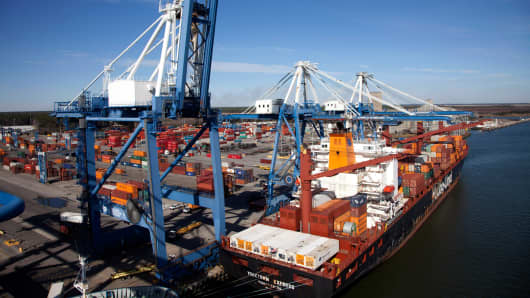This week's announcement that the International Longshoremen's Association and the U.S. Maritime Alliance will go back to the negotiation table to avert a longshoreman's strike that would close 15 ports from Massachusetts to Texas may have retailers and manufacturers cautiously optimistic about a deal, but details about when and where that meeting will be are being kept close to the vest.
If no agreement is reached, 4,500 workers at the 15 ports along the East Coast—including the 4,000 dockworkers in New York and New Jersey— could walk off the job on December 30th. The last time there was an East Coast longshoremen's strike was in 1977.
(Read More: Imminent Threat of Labor Unrest Averted at US Northwest Ports)
The Federal Mediation Conciliation Service said on Monday that director George Cohen called a meeting of the International Longshoremen's Association and the U.S. Maritime Alliance before the Dec. 29 expiration of the dockworkers' contract extension.
Those familiar with the situation tell CNBC that because of the sensitivity of the discussions, details about the meeting will not be disclosed. Talks broke down between the dockworkers and the shipping companies Dec. 18.
Negotiations broke off after shipping management said they want to cap "container royalties," which are payments made to longshoremen based on the weight of the container cargo.
On Wednesday, the threat of imminent labor unrest at four U.S. Pacific Northwest ports was averted after the dockworkers union said its members would stay on the job despite "substandard" contract terms being imposed unilaterally by grain shippers.
(Read More: 'Container Cliff': East Coast Faces 'Devastating' Port Strike)
Robert Kunkel, President of Alternative Marine Technologies and Technical Advisor for Mid Ocean Tanker Company and Alterna Capital Partners, says both the shipping companies and the Longshoreman's Union fail to see the big picture on the economy and the impact a weak economy could have on cargo volumes.
"How do you continue to argue over contractual details knowing our current unemployment rate, the container market and China's slowing growth? While the point of contention is the level of container royalties, we should consider the fact that retailers have reported a poor showing of sales for this Christmas holiday," he said.
"The royalties dispute rises from the carriers and ports anticipating growing volume of Asian cargo at Atlantic ports due to the completion of the Panama Canal expansion. But what should be considered are a poor shipping market and a failing U.S. economy, which may reduce volumes and in turn the amount of work available at the ports."




